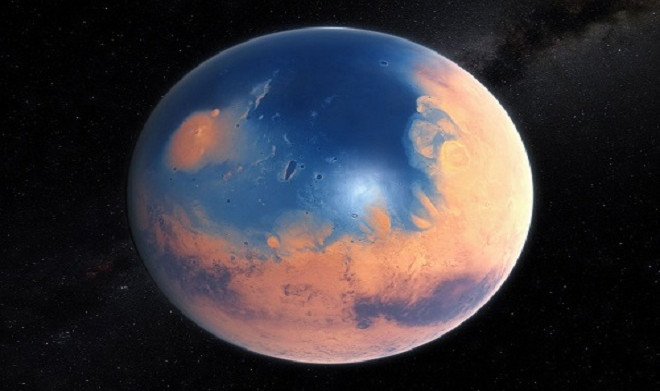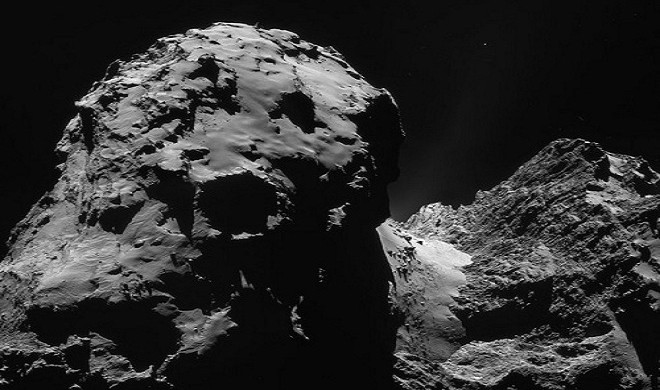8 discoveries indicate life can exist in the planet
The breakthrough astronomical findings in 2015 help scientists have more motivation to prove people are not alone in the universe.
Ocean on Mars

In early 2015, scientists estimated at least one-fifth of the Martian surface covered under a water depth of 137m 4.5 billion years ago.So the sign of life can hide in the ground of Mars.Another finding in August 2015 indicates that water has existed on Mars 200 million years earlier than previously announced.Moreover, life on Earth appears at the same time as the last lakes on Mars, according to Business Insider.(Photo: ESO / M. Kornmesser).
Asteroids and comets sow life germs

According to a scientific report in August 2015, the comet collision with Earth could be the cause of amino acid aggregation and form the first life forms.In the universe, comets can also plant life germs on other planets outside the solar system.(Photo: ESA / Rosetta / NAVCAM).
Water is beneath the crust of Jupiter's Europa

Europa is the sixth satellite, orbiting from inside and out of Jupiter, ranking fourth in size and slightly smaller than the Moon.The brown veins on the satellite surface Europa are said to be warm liquid water permeable from within its crust.According to scientists, beneath the outer shell of Europa is a layer of water.Europa may contain more water than Earth, which is the reason why both the US and Europe are investing hundreds of millions of dollars to make space missions to find life below the satellite surface Europa.(Photo: NASA / JPL / University of Arizona).
The ocean is under the cover of Saturn's Enceladus satellite
Enceladus is Saturn's sixth largest moon. Scientists conclude there is an underground ocean beneath its ice cover. Like Europa, Enceladus' underground ocean is the ideal place for life to exist. Hydrothermal vents are more likely to exist in this underground ocean floor.

Hydrothermal vents are an opening on the planet's surface that creates a warm geothermal water.Areas around the seabed hydrothermal vents are biologically diverse, which can become the home of many complex organizations that live on water-soluble chemicals.(Photo: NASA / JPL / CICLOPS).
Water can exist on 12 bodies in the solar system

In addition to Europa and Enceladus, scientists consider water to exist on 10 other celestial bodies in the solar system.To detect life on these celestial bodies, researchers have to find a way to drill to a layer of water hundreds of kilometers below the celestial surface.(Photo: NASA).
Saturn's Titan satellite lake

Next to Earth, Saturn's largest moon, Titan, is the only object in the solar system that has a lake on the surface.These lakes are unlike lakes on Earth because they contain liquid methane instead of water.However, in early 2015, a team of scientists at Cornell University, USA, pointed out that living cells that rely on methane could exist on Titan satellites.(Photo: NASA / JPL-Caltech / University of Arizona / University of Idaho).
Detecting the Second Earth

It is possible that life only formed and developed on Earth-like planets.The only chance to detect aliens is to search on planets outside the solar system.In July 2015, scientists discovered Earth-like planets named Kepler-452b at 1,400 light-years away.Size, trajectory, star mother and its lifespan are all suitable for life.(Photo: NASA Ames / JPL-Caltech / T. Pyle).
Drake equation and predictions about civilizations in the universe

The famous Drake equation allows scientists to calculate how many extraterrestrial civilizations in the Milky Way.The equation was created by astronomer Frank Drake, depending on many factors such as the rate of star formation, the probability of star having the planet around, the probability of life developing, the average time of a civilization. signaling into space.A scientific report in August 2015 concluded that other galaxies in the universe may contain a number of planets favorable to life more than 10,000 times the Milky Way.(Photo: NASA / Hubble Heritage Team).
- Discovering the planet can survive life
- Does 'twin' planets with Earth exist?
- The Milky Way might contain 10 billion Earth-like planets
- The golden rule of finding alien life
- Extraterrestrial Proxima b can exist in oceans like Earth
- 'Super Earth' may exist near the solar system
- 'Earth copies' can exist in the universe
- 50 trillion planets can contain life in the universe
- Discover planet like earth
- Life may start on Venus
- Live without the sun
- The most Earth-like planet shows up
 Van Allen's belt and evidence that the Apollo 11 mission to the Moon was myth
Van Allen's belt and evidence that the Apollo 11 mission to the Moon was myth The levels of civilization in the universe (Kardashev scale)
The levels of civilization in the universe (Kardashev scale) Today Mars, the sun and the Earth are aligned
Today Mars, the sun and the Earth are aligned The Amazon owner announced a secret plan to build a space base for thousands of people
The Amazon owner announced a secret plan to build a space base for thousands of people